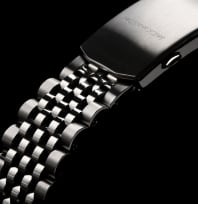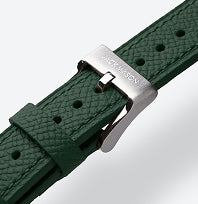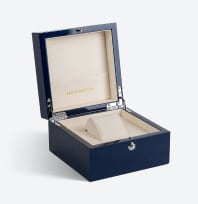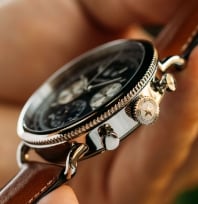Watch collecting is a passion, and being the new guy on the block can be tough. You might be excited to get started and ready to learn the ins and outs of building your watch collection but aren't sure where to start. Even if your current collection is in the early stages, you can stay on par with the seasoned collector by merely knowing your way around your timepiece.
There is a significant misconception among new watch fans that an expensive watch is the best watch, and that a massive collection of watches with intricate mechanisms and endless style makes the man.
An enlightened view of watchmaking is one where balance is vital, and ingenuity takes the place of excess. Starting with the basics and working your way up to the internal mechanisms is the quick start way to the watch aficionado's world.
Like anything regal and just - the most iconic feature of a watch besides the dial itself.
So, What is a Watch Crown?
A watch crown or winding stem is the small ribbed knob located at the 3 o'clock position on most mechanical and automatic watches. Our full collection of watches at Jack Mason herald many a different watch crown. Even solar watches are equipped with crowns to fit in with their mechanical brethren. Probably one of the most essential yet inherently simple parts of a watch is the crown. Its regal name is as apt as its functioning, and this seemingly minute knob is actually directly connected to the watch's internal movement.
The wearer of a mechanical and some automatic watches must manually wind the crown for the watch to work. The crown's primary purpose is to wind the watch's mainspring, which powers the entire functionality of the watch.
Without winding your watch, your watch will die.
A dead watch not only causes you to lose time itself, but it can also impair the future workings of your watch. The simple task of turning a knob every other day will keep your watch in good working order for years. Not to mention the sophisticated ritualistic routine will have you feeling like a watch boss as learning to care for our investments routinely is what makes them an asset.
Typically once the watch is fully wound, it will keep time for 35-45 hours before needing to be rewound. The crown is not just for winding the watch. The crown is also used to set the different watch functions. This includes setting the time down to the minute or even second.
A Quick History of the Watch Crown
Before 1830 watches were wound with a key, much like a grandfather or mantel clock would be. In 1830, Antoine Louis-Breguet sold the first watch with a crown, then simply called a knob, because well, it is a tiny knob, it had the same essential functions of a modern mechanical or automatic watch crown.
Not just for winding, the crown is an all-encompassing mechanism of functionality in a watch:
- The crown is used to wind a watch's mainspring, which provides the 'energy' and power to the watch's internal movement.
- The crown is used to set the time of the watch.
- The crown is used to configure additional components of a watch face like the world clocks or a lunar calendar.
- On a divers' watch, the crown screws down with a water-resistant seal to assist in keeping moisture out of the watch's internal mechanisms.
In a day and age where the watch makes the man, there are several different types of watch crowns based on history, functionality, and luxury. Identifying and understanding the functionality of these various watch crowns can help you make an educated purchase in the future, but it can also help understand where iconic watches come from and how to identify different watches in the real world or private collections.
Not to mention it can be a great conversation starter when you meet someone with a particular watch crown. Don't they say the watch crown is the eyes into one's soul? Well, maybe not, but recognizing different crowns does help you recognize the different watch wearers and what is important to them.
Different Types of Crowns
- Conical Crowns: Conical Crowns have a rounded, usually ribbed top, with tapered sides. The beautiful and easy to grip Jack Mason Avigator crown is a great example. This crown shape is birthed from the early days of aviation. The distinctive feel and tapered edges make the conical crown easily operated while wearing gloves.
- Crowns with Cabochon: A Cabochon crown typically features a small domed gemstone on the top of the crown head. The gemstone itself is entirely decorative and adds additional luxury and an ode to the finer detail echoed in the watch face itself.
- Inset or Screw Down Crown: Subtle in nature, the inset crown is recessed into the watch face or between a crown protector and its design is to protect the watch crown from being snagged on a sleeve or outside material. A good example is our iconic Seamount watch. These crowns are also found on more water-resistant watches and help to create a watertight seal.
- Onion-Shaped Crowns: The onion crown gets its name directly from the shape of the crown. Reminiscent of watches of old, the onion crown is a larger, more bulbous crown that is round and protrudes away from the watch's face. The onion is another popular style on aviator watches as the large crown is easy to grasp with or without gloves.
- Push-Button Crowns: This type of crown has a stopwatch type push button integrated directly into the crown and is often used for chronographs. The ease of the integrated button allows the wearer to start, stop, and reset the chronograph by merely tapping the crown itself, with no extra buttons needed.
- Straight Crowns: The straight crown is the most popular crown due to its simplicity and ease. This style is considered classic and can be found on most collector luxury watches.
However, crowns aren't just for looks; what they boast in design usually mimics its integrity and utility. The crown is used to wind mechanical and automatic watches. It is also used to set the time of the central clock, and in most cases, it is used to set the additional components of the watch, such as the lunar calendar.
How to Wind a Crown
On a mechanical watch, a crown can be used to wind the watch by merely turning the crown in a clockwise position until you feel resistance in the turn. This resistance ensures that the mainspring is tightly wound and will continue to unwind slowly and provide movement or energy to the watch's internal cogs.
On an automatic watch, the crown can be used to wind the watch between wears by turning the crown slightly counterclockwise to the first position and then winding clockwise as you would a mechanical watch till you feel resistance. On an automatic watch, this can be between twenty and forty turns. To secure the crown after winding, you simply push and turn the crown back in until you feel it fit snug against the body of the case.
In Closing
Now that we've expanded your mind to the world of watch crowns, their functionality, history, and potential luxury, you can head on over to our collection of American made watches to test your skills. With a wide array of watch types and styles to choose from Jack Mason will have you invested in your own time in a matter of minutes.
Sources:
https://www.watchmaster.com/en/journal/watch-knowledge/watch-parts-in-focus-watch-crown
https://blog.esslinger.com/watch-crown-illustrations/
https://www.gentlemansgazette.com/watch-parts-terms-functions-guide/









